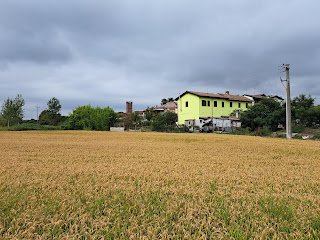Alla mattina appena alzata
o bella ciao bella ciao bella ciao, ciao, ciao
alla mattina appena alzata
in risaia mi tocca andar.
E fra gli insetti e le zanzare
o bella ciao bella ciao bella ciao ciao ciao
e fra gli insetti e le zanzare
un dur lavoro mi tocca far.
Il capo in piedi col suo bastone
o bella ciao bella ciao bella ciao ciao ciao
il capo in piedi col suo bastone
e noi curve a lavorar.
O mamma mia, o che tormento!
o bella ciao bella ciao bella ciao ciao ciao
o mamma mia o che tormento
io t'invoco ogni doman.
Ma verrà un giorno che tutte quante
o bella ciao bella ciao bella ciao ciao ciao
ma verrà un giorno che tutte quante
lavoreremo in libertà.
- original lyrics of Bella ciao
The days when the rice paddies were full of women working bent over double, singing as they weeded the rice, are over, thank goodness, and the big old farm buildings with their dormitories for migrant workers stand empty and decaying in the damp. But has the day yet come when we are all "working in freedom", as the women wished for in the last verse of the song?
 |
| Monument to the mondine in Robbio town hall |
I stopped for a bite to eat in this small town - after which numerous streets in Italian cities are named, because of the importance of the Battle of Palestro in the wars of unification of Italy. On 30–31 May 1859, the combined forces of the Kingdom of Sardinia-Piedmont and France defeated the forces of the Austrian Empire, in what is believed to be the last ever battle with the direct participation of a European sovereign, King Vittorio Emanuele II.
 |
| Depiction of the battle by Luigi Norfini |
But Palestro today is a peaceful, even a sleepy little town. It was raining gently as I arrived, and so I sat in the church listening to the organist rehearsing. Then I found a sports clubhouse with a bar and ordered a cheese and tomato sandwich.
The rain had stopped by the time I left the town centre to return to the Via Francigena, which runs around the outside of the town and then crosses a number of irrigation channels before heading back out into the fields. This section was not on a gravel road but on a narrow, somewhat overgrown trail skirting the edges of the fields.
Nine kilometres further along I reached Robbio, my destination for the evening. I called the number for the one-room municipal hostel and Anna, the volunteer, came to meet me in front of the town hall with the keys. My two Dutch roommates from last night were already in the room resting and recovering from the day's exertions.
I did the same, and then ventured out to see what the town had to offer. The two medieval churches, San Pietro and San Michele, were both closed, so I could only admire their brick exteriors.
 |
| San Pietro |
 |
| Decorated brick door of San Michele |
The only church that was open was the parish church of Santo Stefano, the one that interested me the least, because it "only" dates back to 1795 - very new, by Italian standards! But inside was a 16th-century altarpiece by Giovenone, the painter whose works I have kept seeing over the past few days.
Robbio also has a castle, originally 14th-century but rebuilt in the 16th century and "restored" with a heavy hand in the late 19th and early 20th century. However the outbuildings are now private homes, and the main part of the castle is closed for renovation/restoration work, so there was not much to see there, either!
I returned to the hostel to put on long trousers - as protection against mosquitoes, not cold - and then headed out to a café for some dinner.
 |
| Gnocchetti with red pepper sauce and toasted hazelnuts 😋 |
Vercelli - Robbio 21 km (including detour to Palestro town centre)























Kay and I stayed there in Robbio, it was 40deg and so hot in that Albergue. I recall we had trouble with the key trying to open the front gates to the complex after hours, but luckily a local came by and rescued us.
ReplyDeleteI had a little trouble getting out for dinner after they locked the big gate 😅 Brief panic attack as I had no food left... but I soon figured it out!
Delete